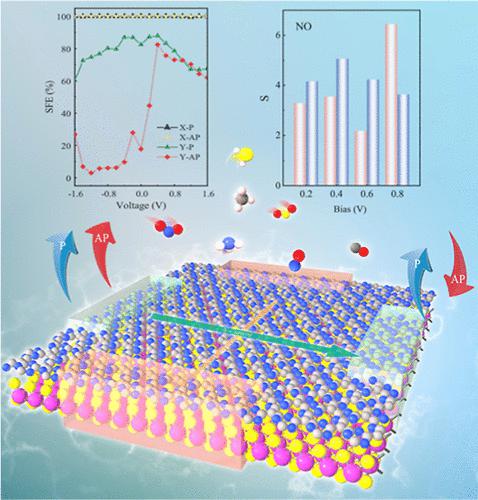Our official English website, www.x-mol.net, welcomes your
feedback! (Note: you will need to create a separate account there.)
Multifunctional 2D g-C4N3/MoS2 vdW Heterostructure-Based Nanodevices: Spin Filtering and Gas Sensing Properties
ACS Sensors ( IF 8.2 ) Pub Date : 2022-11-07 , DOI: 10.1021/acssensors.2c01785 Xiansheng Dong 1 , Tong Chen 1, 2 , Guogang Liu 1 , Luzhen Xie 1 , Guanghui Zhou 3, 4 , Mengqiu Long 5
ACS Sensors ( IF 8.2 ) Pub Date : 2022-11-07 , DOI: 10.1021/acssensors.2c01785 Xiansheng Dong 1 , Tong Chen 1, 2 , Guogang Liu 1 , Luzhen Xie 1 , Guanghui Zhou 3, 4 , Mengqiu Long 5
Affiliation

|
Two-dimensional (2D) magnetic materials are the key to the development of the new generation in spintronics technology and engineering multifunctional devices. Herein, the electronic, spin-resolved transmission, and gas sensing properties of the 2D g-C4N3/MoS2 van der Waals (vdW) heterostructure have been investigated by using density functional theory with non-equilibrium Green’s function method. First, the g-C4N3/MoS2 vdW heterostructure demonstrates ferromagnetic half-metallicity and superior adsorption capacity for gas molecules. The spin-dependent electronic transport of the g-C4N3/MoS2-based nanodevice is obviously regulated by parallel or anti-parallel spin configuration in electrodes, leading to perfect single-spin conduction behavior with a nearly 100% spin filtering efficiency, a negative differential resistance effect, and other interesting electrical transport phenomena. Moreover, g-C4N3/MoS2 exhibits directional dependency and strong transport anisotropic behavior under bias windows, indicating that the electric current propagates more easily through the vertical direction than the horizontal direction. The physical mechanisms are revealed and analyzed by presenting the bias-dependent transmission spectra in combination with the projected local device density of states. Finally, the g-C4N3/MoS2-based gas sensor is more sensitive to CO, NO, NO2, and NH3 molecules with the chemisorption type. The strong chemical adsorption leads to the formation of electrons on the local scattering center and ultimately affects the transport properties, resulting in the maximum gas sensitivity reaching 6.45 for NO at the bias of 0.8 V. This work not only reveals that the g-C4N3/MoS2 vdW heterostructure with high anisotropy, perfect spin filtering, and outstanding gas sensitivity is a promising 2D material but also provides an insight into the further application in futuristic electronic nanodevices.
中文翻译:

基于多功能二维 g-C4N3/MoS2 vdW 异质结构的纳米器件:自旋过滤和气体传感特性
二维 (2D) 磁性材料是发展新一代自旋电子技术和工程多功能器件的关键。在此,使用密度泛函理论和非平衡格林函数方法研究了 2D gC 4 N 3 /MoS 2范德华 (vdW) 异质结构的电子、自旋分辨传输和气体传感特性。首先,gC 4 N 3 /MoS 2 vdW异质结构表现出铁磁半金属性和对气体分子的优异吸附能力。gC 4 N 3 /MoS 2的自旋相关电子传输基于-的纳米器件明显受电极中平行或反平行自旋配置的调节,导致完美的单自旋传导行为,具有接近 100% 的自旋过滤效率、负微分电阻效应和其他有趣的电传输现象。此外,gC 4 N 3 /MoS 2在偏置窗口下表现出方向依赖性和强传输各向异性行为,表明电流在垂直方向比水平方向更容易传播。通过结合预测的局部器件状态密度呈现依赖于偏置的透射光谱来揭示和分析物理机制。最后,gC 4 N 3/MoS 2基气体传感器对化学吸附型CO、NO、NO 2和NH 3分子更敏感。强烈的化学吸附导致在局部散射中心形成电子并最终影响传输特性,导致在 0.8 V 的偏压下对 NO 的最大气体灵敏度达到 6.45。这项工作不仅揭示了 gC 4 N 3 /MoS 2 vdW 异质结构具有高各向异性、完美的自旋过滤和出色的气体敏感性,是一种很有前途的二维材料,同时也为未来电子纳米器件的进一步应用提供了思路。
更新日期:2022-11-07
中文翻译:

基于多功能二维 g-C4N3/MoS2 vdW 异质结构的纳米器件:自旋过滤和气体传感特性
二维 (2D) 磁性材料是发展新一代自旋电子技术和工程多功能器件的关键。在此,使用密度泛函理论和非平衡格林函数方法研究了 2D gC 4 N 3 /MoS 2范德华 (vdW) 异质结构的电子、自旋分辨传输和气体传感特性。首先,gC 4 N 3 /MoS 2 vdW异质结构表现出铁磁半金属性和对气体分子的优异吸附能力。gC 4 N 3 /MoS 2的自旋相关电子传输基于-的纳米器件明显受电极中平行或反平行自旋配置的调节,导致完美的单自旋传导行为,具有接近 100% 的自旋过滤效率、负微分电阻效应和其他有趣的电传输现象。此外,gC 4 N 3 /MoS 2在偏置窗口下表现出方向依赖性和强传输各向异性行为,表明电流在垂直方向比水平方向更容易传播。通过结合预测的局部器件状态密度呈现依赖于偏置的透射光谱来揭示和分析物理机制。最后,gC 4 N 3/MoS 2基气体传感器对化学吸附型CO、NO、NO 2和NH 3分子更敏感。强烈的化学吸附导致在局部散射中心形成电子并最终影响传输特性,导致在 0.8 V 的偏压下对 NO 的最大气体灵敏度达到 6.45。这项工作不仅揭示了 gC 4 N 3 /MoS 2 vdW 异质结构具有高各向异性、完美的自旋过滤和出色的气体敏感性,是一种很有前途的二维材料,同时也为未来电子纳米器件的进一步应用提供了思路。

































 京公网安备 11010802027423号
京公网安备 11010802027423号